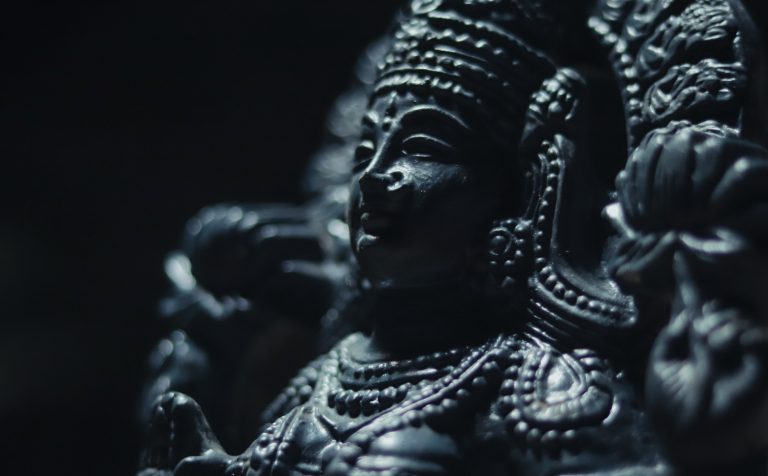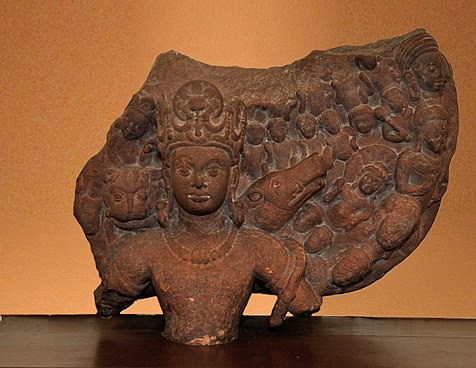Hinduism, a way of life for over a billion people worldwide, is also the oldest religion on earth. With a history spanning over a millennium, its philosophies and spiritual concepts have grown increasingly complex with time, ultimately leading to a misinterpretation of its core values. However, this complexity has been addressed through the creation of symbols, which have become an integral part of Hinduism. These symbols, whether in the form of an image, icon, or religious practice, represent a concept, spiritual belief, or deity, simplifying the depth of the theory. With time, these symbols have gained immense respect and significance, often being associated with God themselves.
From icons to statues and holy actions, symbols in Hinduism come in various forms. Every act, every tattoo, every marking on the body, and every piece of jewelry represents something deeper and divine. While all religions have symbols, none match the grandeur and diversity found in Hinduism. These seemingly bizarre icons and practices play a vital role in religion and help people find meaning in the abstract and intangible philosophies of Hinduism.
Iconography in Hinduism
Iconography is a crucial element of the symbolic language of Hinduism, and its icons are perhaps the most widely recognized symbols of the religion. These icons represent a vast array of divine concepts and philosophies and have traveled far beyond the boundaries of Hinduism, becoming recognizable in various parts of the world. The simplicity and versatility of these symbols have contributed to their popularity, making them accessible and understandable to people from different cultures and backgrounds. The impact of these icons extends far beyond their religious significance, serving as a testament to the rich cultural heritage of India and its people.
Om (Aum)
The ‘Om’ symbol, also known as Pranava, Omkara, and Ekakshara, is widely regarded as the most supreme and imperishable syllable in Hinduism. It is considered a sacred sound that represents the essence of the Universe and is believed to be the vibration of creation itself. The symbol is deeply ingrained in Hindu culture and is used in a variety of ways, including during meditation, prayer, and spiritual practices.
The spiritual significance of the ‘Om’ symbol lies in its ability to unite the individual soul with the Universal soul. When the sound of ‘Om’ is chanted, it is said to create a vibration that travels from the pit of the stomach to the mouth, where it is released into the world. This vibration is believed to synchronize the spiritual frequency of the person chanting with that of the Universe, creating a temporary union between the individual soul, or Atman, and the Universal soul, or Brahman.
The ‘Om’ symbol has its origins in the ancient Hindu texts known as the Upanishads, where it was revered as the “cosmic sound” and an indication of abstract reality. Over time, it became associated with knowledge and was interpreted as the entire teachings of the Vedas, the oldest Hindu scriptures. Today, the ‘Om’ symbol is recognized and revered by millions of people all over the world, both within and outside of Hinduism.
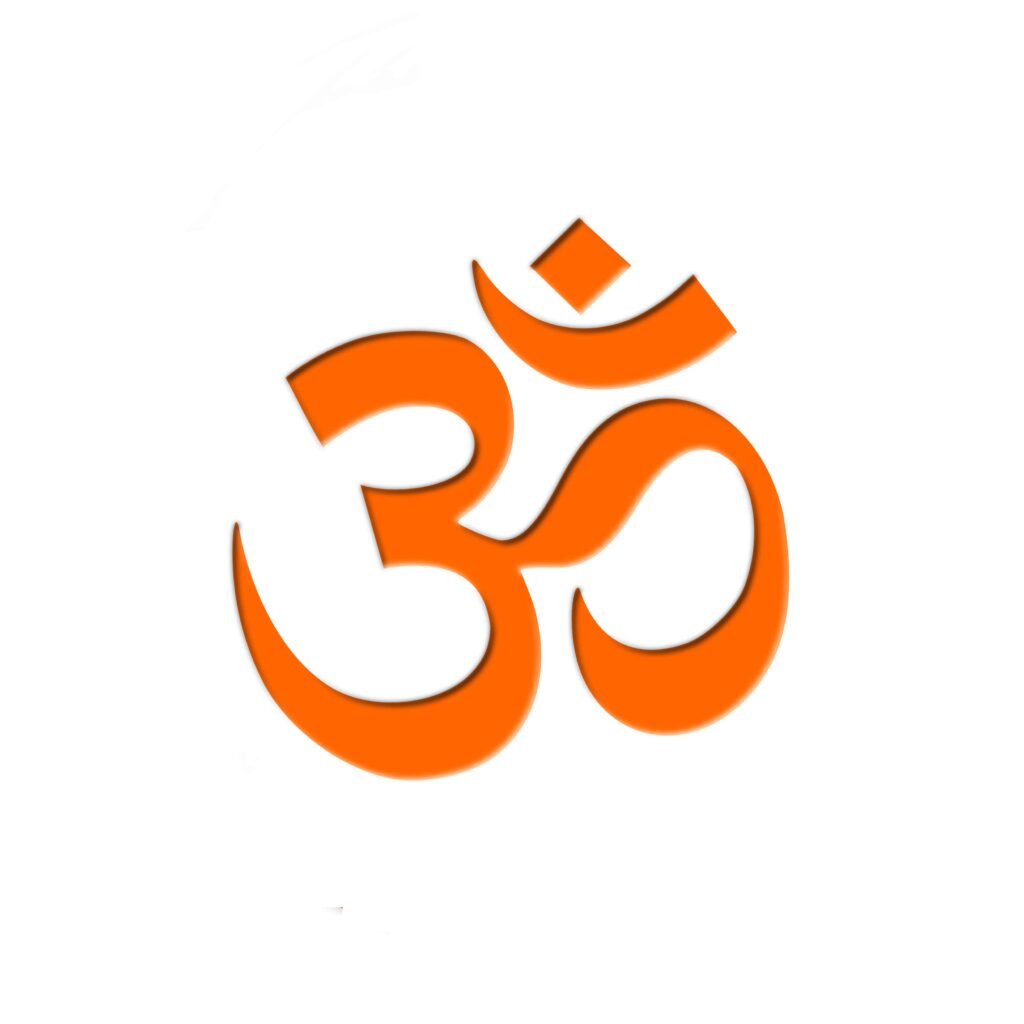
(Public Domain)
Throughout the centuries, the ‘Om’ symbol has gained significant prominence and come to symbolize numerous spiritual philosophies in Hinduism, often associated with the divinity of the Brahman. The symbol can be found in almost every major holy scripture in Hinduism, with slight variations in interpretation each time. For instance, in the Bhagavad Gita, Krishna reveals his true form to Arjuna and identifies himself as the syllable ‘Om’. In the Puranas, a more recent Hindu text, the symbol is linked with the Trimurti – The Three Supreme Gods In Hinduism.
Despite being associated with varying meanings, the true essence of ‘Om’ signifies the union of man and the universe. It represents the eternal vibration that momentarily liberates the individual from the constraints of the soul.
Swastika
The term Swastika is derived from the Sanskrit word ‘Swasti’ which means auspicious or fortunate. In Sanskrit literature such as the Vedas, this term is used in the context of promoting the health and well-being of individuals. The Swastika symbol itself is over ten thousand years old and possesses extreme spiritual importance in Hinduism. The chiral symmetry of the symbol allows for it to be interpreted in two ways, with the right-facing Swastika representing the glory of the Sun God, Surya, and symbolic of good luck. On the other hand, the left-facing symbol, known as the Sauvastika, derives its name from the Sanskrit word ‘Sau’, meaning bad, and symbolizes night and the tantric aspects of Kali.
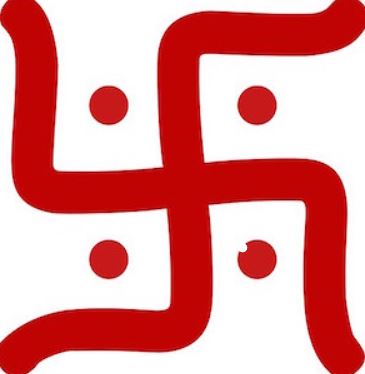
(Public Domain)
Although the Swastika originated in Hinduism, it was adopted by different religions and social groups across the world, each interpreting the symbol differently. In India, where the majority of the population is Hindu, the Swastika held different meanings in different religions. For instance, in Jainism, it symbolized the 7th spiritual teacher, while in Buddhism, it represented the footprints of Buddha.
As the symbol spread westward, it lost much of its original meaning and became associated with negativity. Although it had appeared in Baltic and Slavic cultures, its most infamous association is with the Nazis during World War II. Under Hitler’s regime, the Swastika became a symbol of racial superiority, erasing the symbol’s ten-thousand-year-old spiritual legacy in just a few years.
Despite its misrepresentation in the West, the Swastika remains a symbol of great spiritual value in Hinduism. During the Hindu festival Diwali, the symbol is seen throughout the country, with people creating Swastika rangolis at their homes to attract good luck. The unique symmetry of the symbol, along with its rich and diverse history, makes it one of the most significant symbols in Hinduism. Additionally, it is a sign of the divine feminine energy, Shakti.
Sri Yantra
The Sri Yantra is a highly intricate and elaborate symbol with immense significance in Hinduism. It features nine interlocking triangles that combine to form 43 smaller triangles, all surrounding a central point called the Bindi. Two concentric circles circumscribe the triangles, with 16 petals and 8 petals respectively. The entire pattern is enclosed within a square with broken lines on each side, symbolizing four ways leading to different directions.
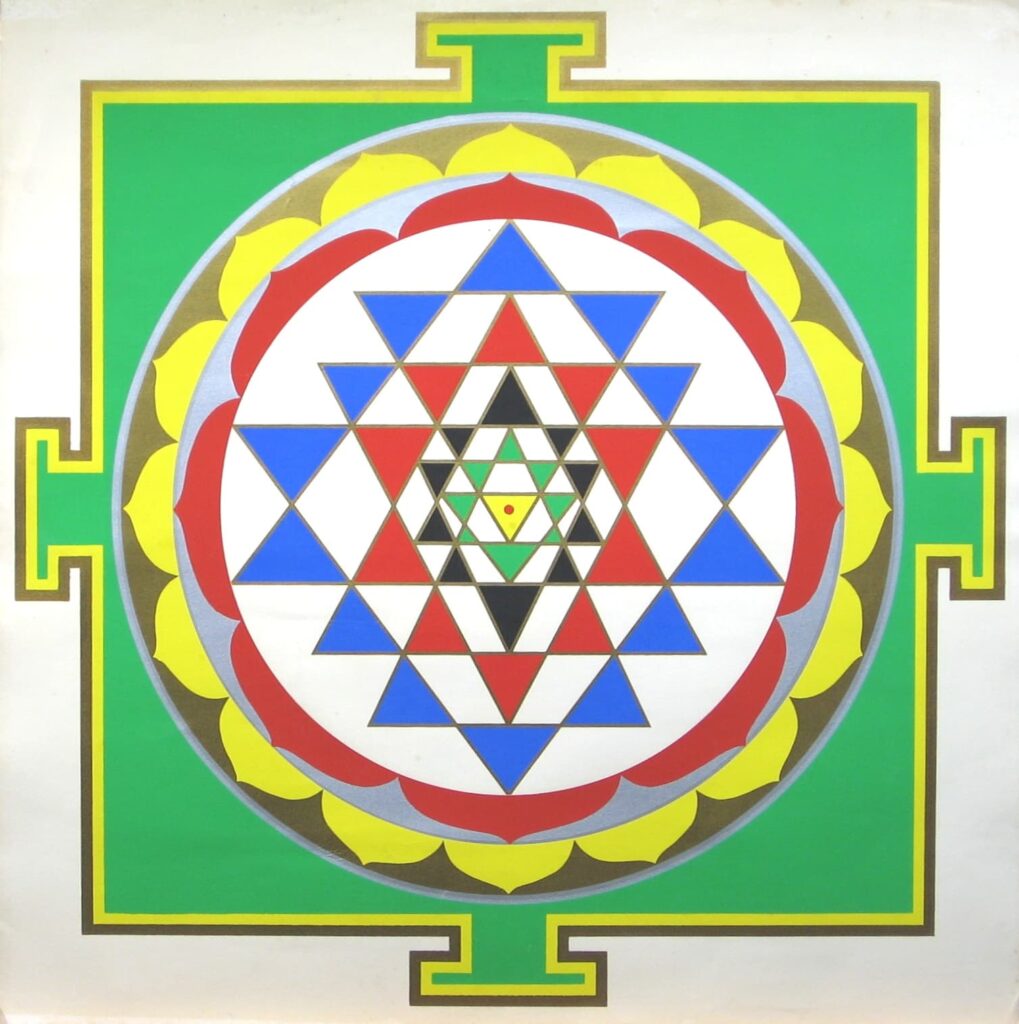
(Public Domain)
Not only is the symbol visually complex, but its conceptual interpretation is equally intricate. It conveys the concept of Advaita or non-duality, which emphasizes the existence of the Brahman. The bindi at the center represents the universe’s center, while the petals depict the lotus of creation.
The Sri Yantra is also associated with the worship of the Hindu Goddess shakti, who is revered as the mother of the universe. The four upward-pointing triangles represent the male avatar of the Goddess, known as Brahm, while the five downward-pointing triangles represent the feminine version, Jagat Janani. The Sri Yantra is also called the ‘nav chakra’ due to its nine concentric formations.
Trikona
In Hinduism, trinities play an extremely vital role. From the three major deities to multiple spiritual concepts, all of them have underlying ternary relations. Therefore it is only natural that there are multiple symbols in Hinduism that represent trichotomic concepts. The Trikona is one such symbol resembling a triangle and is used to represent multiple trinities in Hinduism. Hinduism holds a significant belief in trinities, with multiple deities and spiritual concepts having underlying ternary relations. Therefore, it is no surprise that Hinduism features numerous symbols representing trichotomic concepts. The Trikona, resembling a triangle, is one such symbol used to represent trinities in Hinduism.
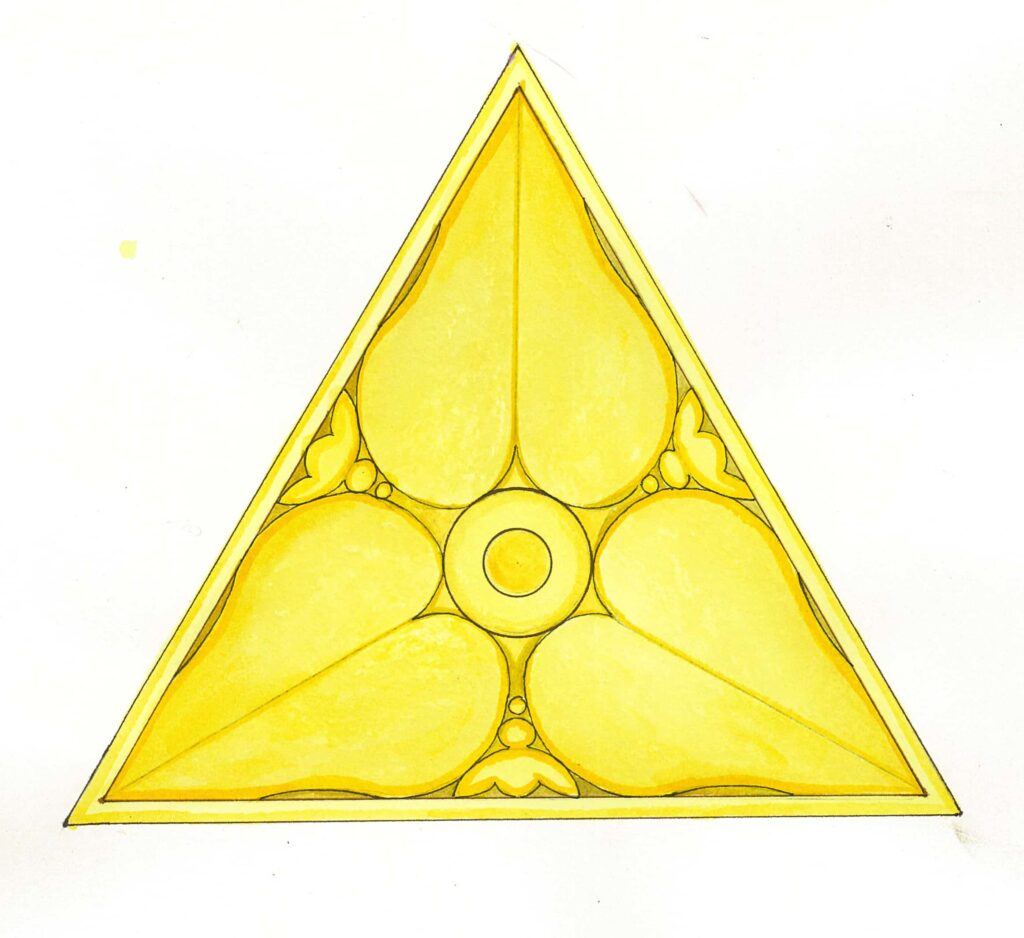
(Public Domain)
The Trikona holds a major symbolism of Shiva’s absolute form, representing the creator, preserver, and destroyer. Beyond spiritual practices, this symbol also carries immense importance in the fields of astrology and meditation. Its symmetrical triangular structure is believed to enhance concentration and facilitate one’s connection with their soul.
Shatkona
The Shatkona, also known as the six-pointed star, is formed when two Trikonas are invertedly overlapped. The upper triangle of the star represents Shiva, while the lower triangle symbolizes Shakti – The Hindu Goddess of Life. The Shatkona represents the genderless form of power, signifying that power or Shakti transcends the boundaries of the universe. Another version of the symbol includes it being encircled by 12 petals, known as the Anahata Chakra or the heart chakra, which represents the tantric element within an individual.

(Public Domain)
The impact of the Shatkona on western culture, particularly Judaism, is noteworthy. The symbol of the Shatkona is similar to the Star of David in Jewish culture. Both symbols are six-pointed stars that have a rich spiritual significance and are representative of the interconnectedness of different elements.
Symbols associated with Gods and Deities
Hinduism is a religion with a vast pantheon of gods and goddesses, with over 330 million divine beings. Consequently, it is no wonder that many of these deities are represented through a wide range of unique symbols and objects. One of the distinguishing features of spiritual symbolism in Hinduism is that multiple objects can symbolize the same deity, and numerous deities can be represented by the same object. These symbols span from iconic mythical weapons to even everyday objects, demonstrating the depth and richness of Hindu iconography.
Sudarshana Chakra
Vishnu’s Chakra, also known as the Sudarshana Chakra, is a powerful weapon that symbolizes the protection offered by Lord Vishnu. The disc-like weapon has 108 serrated edges and was initially regarded as the wheel of time in the Rig Veda.
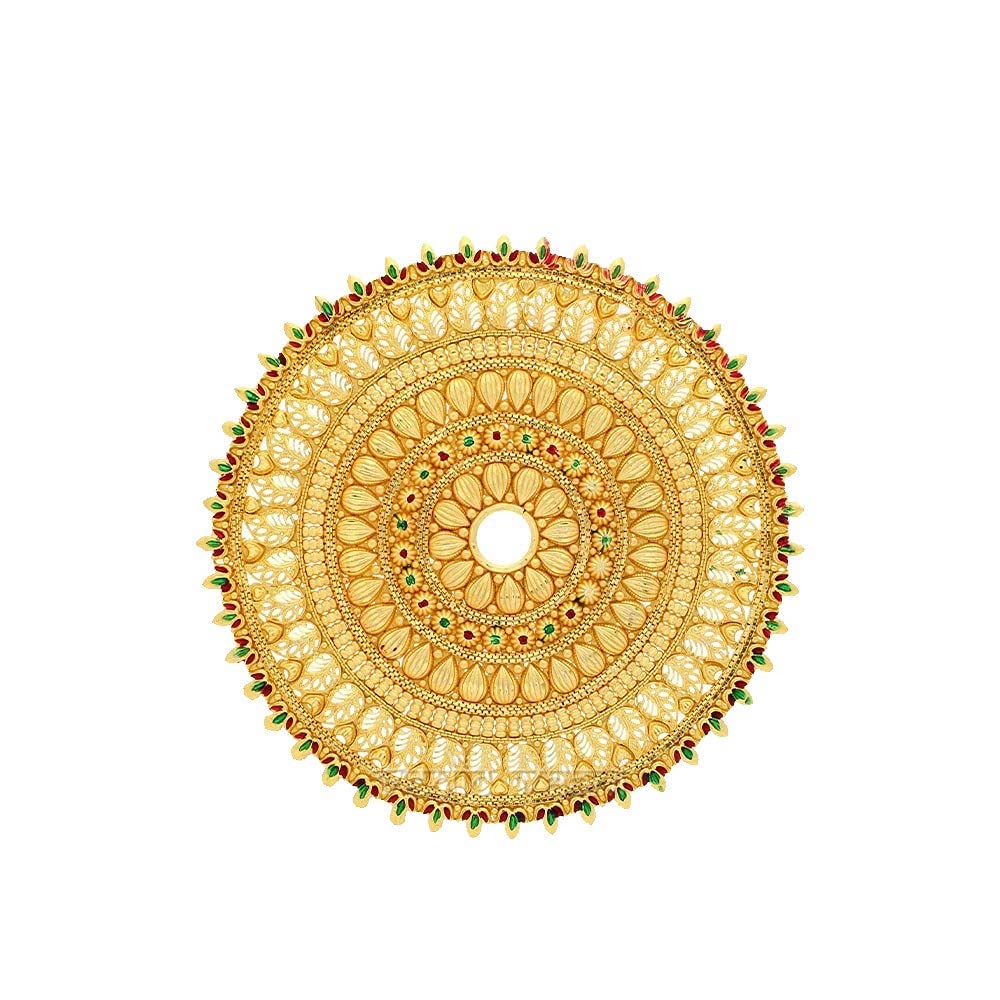
(Public Domain)
However, later interpretations depict it as a weapon used by Vishnu to defeat demons. Vishnu holds the Chakra in his rear right hand as one of the four objects he holds in his four hands. The Sudarshana Chakra is one of the most respected and feared symbols in Hinduism and has appeared in many mythological tales.
Padma (Lotus)
The Lotus is a powerful symbol in Hinduism, often associated with the origin story of Hinduism. According to Hindu mythology, Brahma, the divine creator, was believed to be seated on a Lotus before the Universe came into existence. It is said that upon Lord Vishnu’s command, Brahma divided the Lotus into three parts, creating Heaven, Earth, and Hell. Thus, the lotus is closely linked with the concept of creation and is often used to symbolize Brahma’s role in bringing the Universe into being.
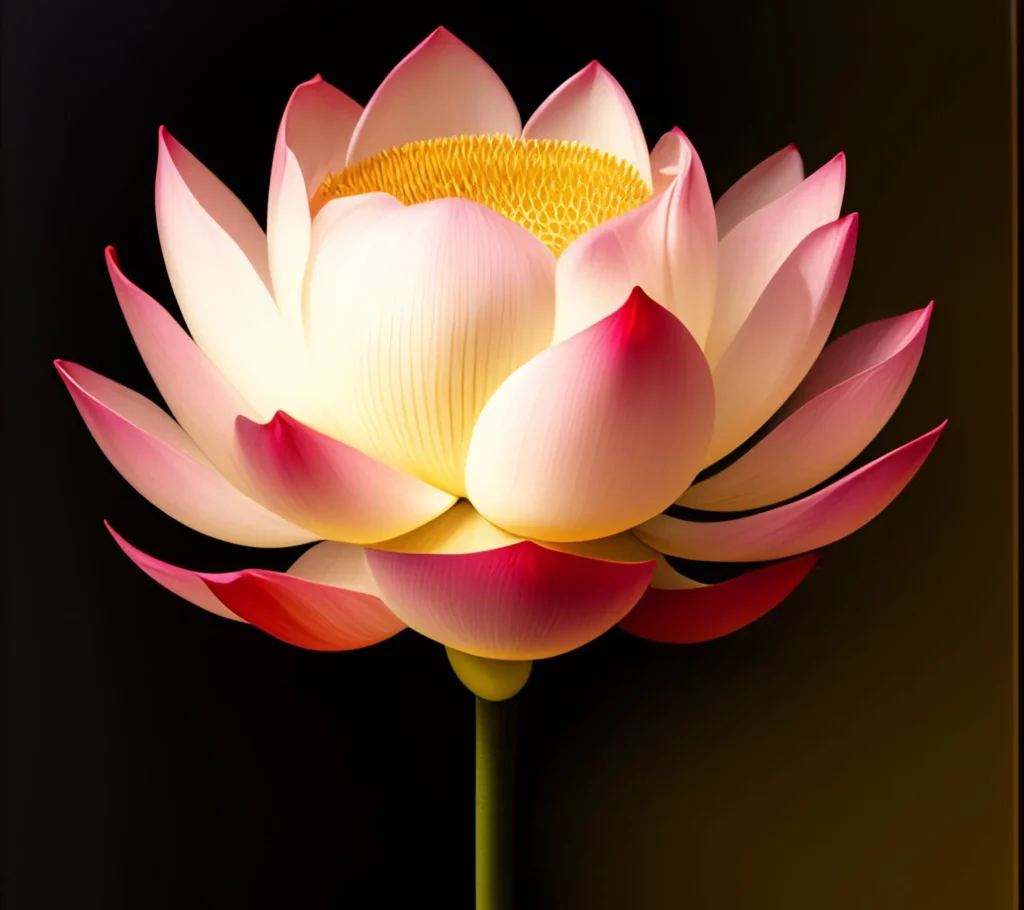
© Vedgyaan.com
Apart from its association with the creation story, the flower is also held sacred by the Gods Vishnu and Lakshmi. In Hindu iconography, Lord Vishnu is often depicted holding a Lotus in one of his four hands, representing purity and divine beauty.
However, the symbolism of the Lotus goes beyond its association with deities. The flower represents spiritual purity, enlightenment, and detachment. Its ability to grow and bloom even in murky waters without getting affected by the impurities around it is a powerful lesson for humanity. The Bhagavad Gita, a sacred text in Hinduism, draws a parallel between the Lotus and human existence, urging individuals to live a life free from materialistic attachments and stand apart from the figurative mud and water. Hence, the Lotus is not just a flower but a symbol of spiritual awakening and self-realization.
Shiva Lingam
The Shiva Lingam is a significant and sacred symbol associated with the deity Shiva, one of the most revered gods in Hinduism. Typically constructed with black spotless stone, the Lingam is a cylindrical structure with rounded tops that represents the inexplicable form of Para Shakti or eternal power. The simple yet powerful design of the symbol holds great spiritual significance for Hindus.
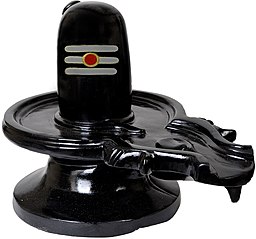
(Public domain)
A single complete Shiva Lingam, also known as an Acala Shivalingam, represents not only Shiva but all three major deities in Hinduism. The first part of the Lingam is dedicated to Shiva, while the second and third sections represent Vishnu and Brahma, respectively. This symbolizes the unity and interconnectedness of the divine trinity in Hinduism. The Shiva Lingam is considered the most auspicious symbol of Shiva, and it is often worshipped in Hindu temples and households worldwide.
Veena
Veena is a string instrument that is predominantly found in the Indian subcontinent and is considered a major symbol in Hinduism. The instrument is primarily associated with the Hindu Goddess Saraswati – The goddess of knowledge. The Veena, true to the nature of its patron goddess, is symbolic of knowledge, art, and learning.
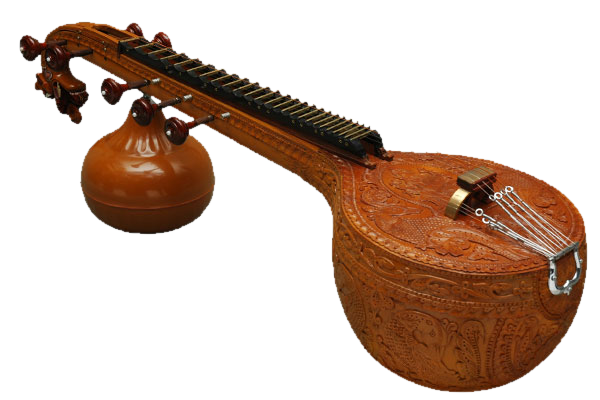
(Public Domain)
Similar to the symbol ‘Om’, the sound created by the instrument is of high importance. The melodious sound made by the Veena conveys to people, the importance of maintaining harmony and understanding the deeper meaning of life.
Trishula
The Trishula, a significant symbol in Hinduism, consists of three spokes which hold great symbolic meaning. These spokes are often interpreted as representations of the three primary deities of the Hindu pantheon: Vishnu, Brahma, and Shiva.
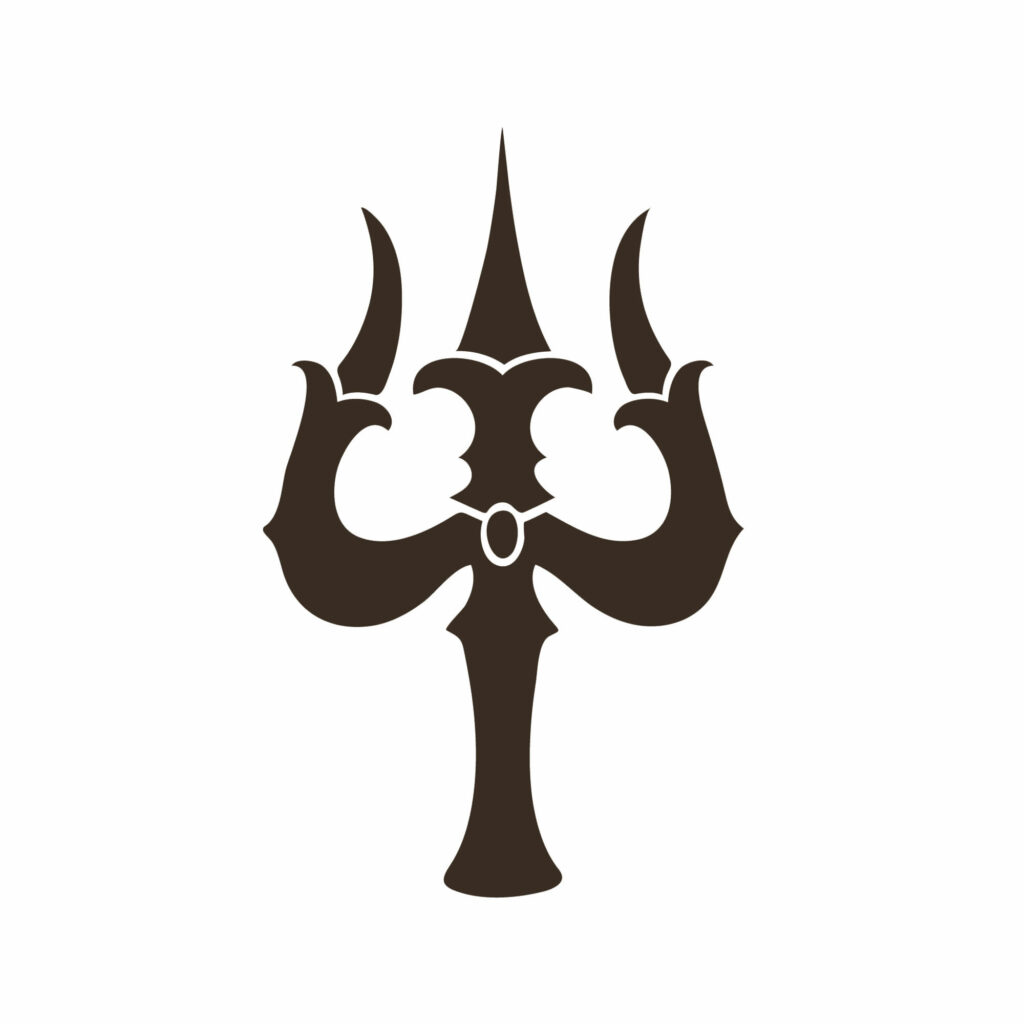
(Public Domain)
The Trishula holds a significant place in Hinduism as it embodies the importance of balancing the three universal forces of creation, preservation, and destruction. This ancient symbol is associated with various spiritual trinities, including –
- Past, Present, and Future
- Body, Mind, and Atman
- Hell, Heaven, and Earth.
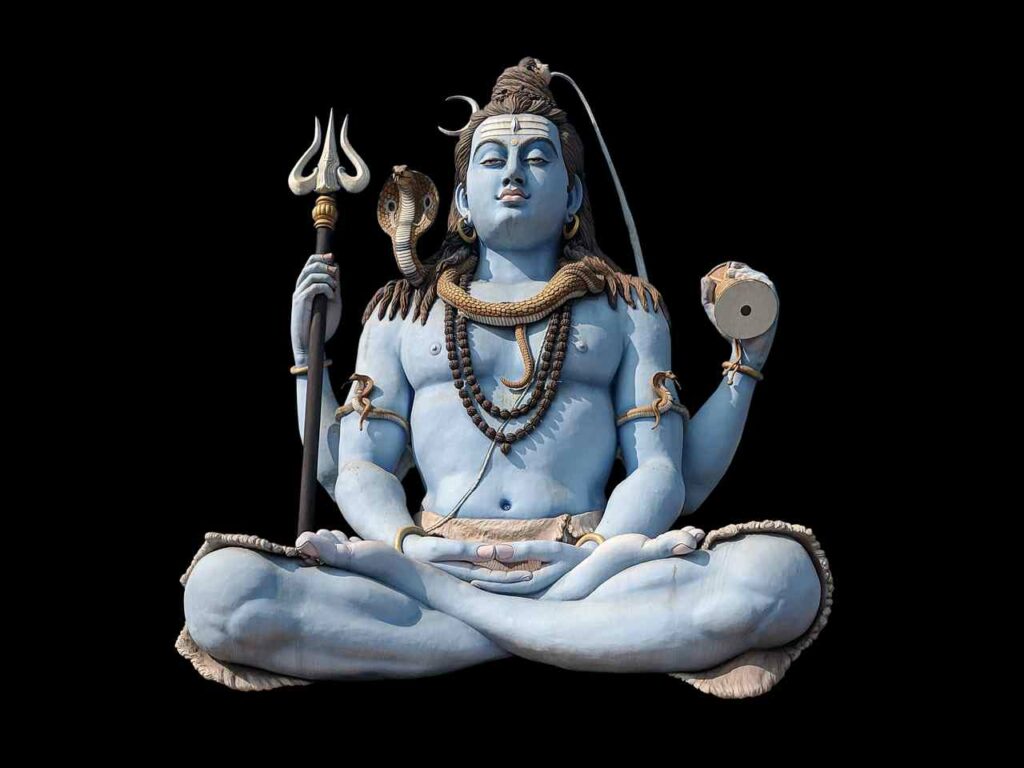
(Public Domain)
However, one of the most prominent trinities represented by the Trishula is the three Gunas or values of Rajas, Tamas, and Satva. These values respectively signify passion, calmness, and ignorance, and their balance is crucial in achieving spiritual harmony. The Trishula is a powerful reminder of the need to keep these values in equilibrium and embrace the diverse aspects of the universe to attain spiritual enlightenment.
Symbolic Objects in Hinduism
Symbolic objects play a crucial role in Hinduism, as they represent deep spiritual concepts and ideas. These objects can range from simple vessels of water to abundant trees, and even animals. It is fascinating to observe how seemingly ordinary objects carry religious and divine significance in Hinduism, reminding the faithful of the interconnectedness of all things and the sacredness of everyday life. These objects are imbued with meanings that reflect the rich and complex tapestry of Hindu philosophy and spirituality and serve as powerful reminders of the presence of the divine in all things.
Shankha
The Shankha, also known as the conch shell, is one of the four items held by Lord Vishnu in his arms. It has a literal meaning of “Conch Shell” and was traditionally used as a trumpet to mark the beginning of a battle. While traditional warfare is no longer prevalent in India, the Shankha is still blown before religious ceremonies and major events as a symbol of auspiciousness and prosperity.

(Public Domain)
In Hindu scriptures, the conch is also symbolic of fame, longevity, and prosperity. Its sound is considered equivalent to the universal vibration of ‘Om,’ the primordial sound of creation. Moreover, the Shankha is believed to have the power to cleanse sins and is considered the abode of Lord Vishnu’s consort, Goddess Lakshmi, the goddess of wealth and prosperity.
Dhvaja
Dhvaja is the Sanskrit word for flag, which is a saffron-colored banner that is traditionally used to signify victory in Hindu culture. These flags are typically displayed on chariots and symbolize the restoration of dharma.
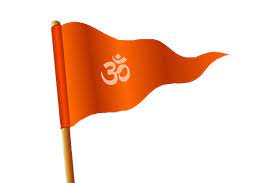
(Public Domain)
In more modern times, Dhvajas are often placed atop temples and other places of worship. The bright orange color of these flags represents the radiant light of the sun, guiding people to the temple and offering them solace.
Vata (Banyan Tree)
The banyan tree, also known as the Vata tree, holds great significance in Hinduism and is often considered the symbol of love. Its ever-expanding branches and roots represent longevity, immortality, and the indestructible soul or atman. The tree’s association with Brahma, the god of creation, reflects its connection to the cycle of life and death. In addition, the Vata is also associated with Yama – The God of Death, as spirits of those who have passed away, are believed to visit banyan trees.

(Public Domain)
The interconnected branches of the banyan tree are seen as a representation of the rich cultural heritage of Hinduism and India. Furthermore, the banyan tree also symbolizes knowledge, wisdom, and enlightenment, as it is believed that Lord Buddha achieved enlightenment while meditating under a banyan tree. The banyan tree’s symbolic value is so profound that it is often referred to as the ‘wish-fulfilling tree.’ Overall, the banyan tree’s significance in Hinduism goes beyond its physical form, representing various aspects of life and spirituality.
Bael Tree
The Bilva or Bael tree is another significant tree in Hinduism with spiritual significance. Its leaves, which are made up of three folds, represent the three eyes of Shiva. The Bael leaf is believed to be Lord Shiva’s favorite leaf, and it is one of the six essential items used to worship the deity. The fruit of the Bael tree is also considered to be a symbol of fertility and is used in various religious rituals.

© Vedgyaan.com
The tree is often planted in temple courtyards, and its leaves and fruit are offered during worship to seek blessings from Lord Shiva. In addition, the Bael tree is believed to have medicinal properties and is used in Ayurvedic medicine. It is also known as the “wood apple” and is used in various culinary dishes. Overall, the Bael tree is a significant symbol in Hinduism representing Lord Shiva and fertility.
Kamandalu (Water Vessel)
The Kamandalu, a small oblong water pot carried by ascetics and yogis for drinking water, is not merely a practical object but also a rich symbol in Hinduism. The water contained in the Kamandalu is believed to transform into Amrita, the elixir of life, imbuing it with symbolism related to fertility, life, and wealth.

(Public Domain)
Furthermore, the Kamandalu is often depicted alongside deities who espouse a simple, spiritual life, thus symbolizing asceticism. For example, Shiva, Brahma, Vishnu, and their respective female counterparts are often portrayed holding the Kamandalu.
Animals as Symbols
In Hinduism, animals hold a significant place in forming the symbols of the faith. Many animals act as a mount for major deities and are symbolic of the gods they serve. The practice of zoomorphism is crucial in Hinduism, where animals are considered as important as humans and are given the same respect if not more. To validate this notion, many animals have come to represent deeper meanings and are even worshipped.
Cow
The cow (Sanskrit: Gou) is the most sacred animal in the Hindu faith. Unlike most cultures where cows are used for meat, Hinduism abides by a strict code of ethics that prevents people from harming any domestic animal. The cow’s credentials as the provider of milk have earned her the title of mother, as she is the one who feeds everyone. This is also the reason why the cow is symbolic of life and protection.
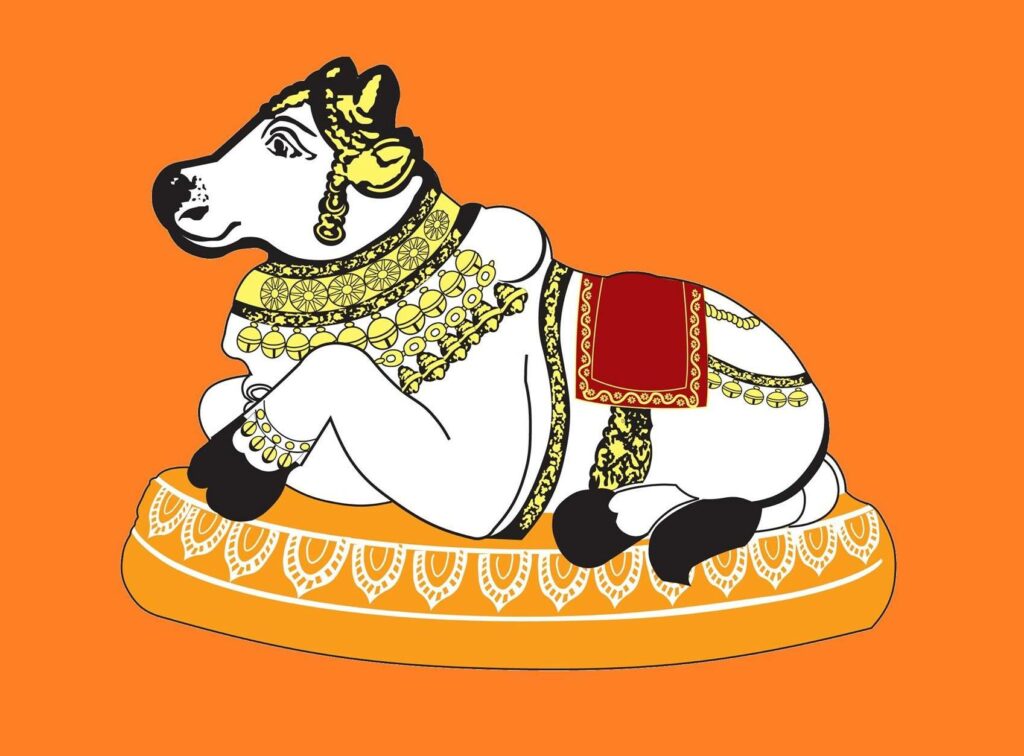
(Public Domain)
While not all cows are worshipped as deities, few have played a special role in mythology. Nandi, the bull, is Lord Shiva’s ride and his most loyal follower. Additionally, the Cow Kamadhenu is considered the mother of all cows and is known to provide her owner with everything he wishes for.
Ganesha
Lord Ganesha is arguably one of the most beloved gods in Hinduism. The deity has the body of a human being but sports the head of an elephant. Ganesha, as a symbol, is used to mark the beginning of occasions and to uphold the spirit of dharma.
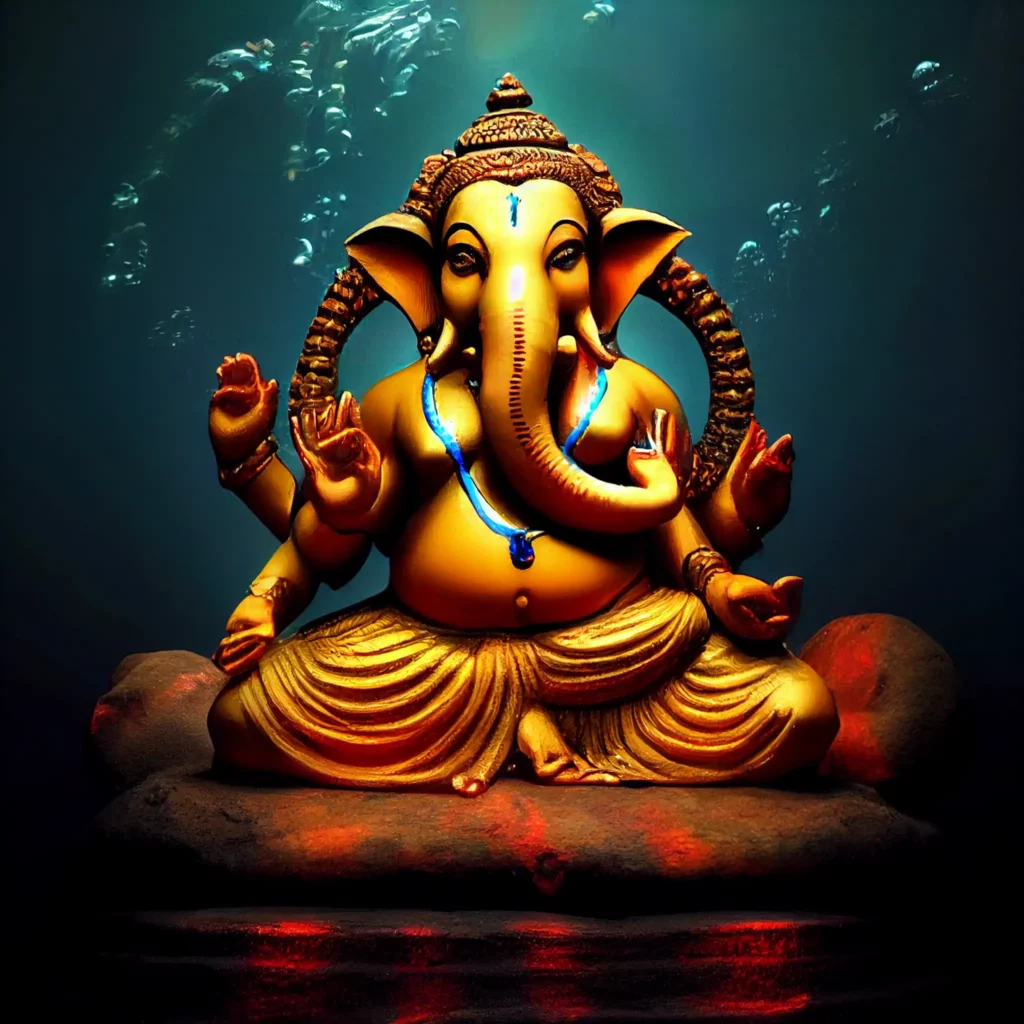
© Vedgyaan.com
A distinct feature of the deity is the various interpretations he has held over time. Unlike some deities who are only associated with one core ability, Ganesha has been portrayed as not only a warrior, but also a dancer, a singer, and a loving child to his parents Shiva and Parvati.
Peacock
In Hindu mythology, the peacock (Sanskrit: Mayur) is a significant bird and plays various roles. It is the mount of the Hindu God Of War – Lord Kartikeya and represents his stealth and beauty. The peacock’s feathers display the divine symbol of ‘Om’ when it spreads them, making it a sacred bird in Hinduism. Lord Krishna, an avatar of the supreme deity Vishnu, is often depicted with a peacock feather on his head. According to legend, when Krishna entered the forest, the peacocks would dance in delight and invoke rain to the land, which symbolizes the bird’s association with nature and its importance in maintaining the balance of the ecosystem. The peacock is also considered a symbol of love, compassion, and prosperity in Hinduism.

(Public Domain)
The peacock symbol has been popular in India since ancient times, but it gained widespread significance during the Maurya dynasty. The name ‘Maurya’ literally means ‘like a peacock’ and was adopted due to the belief that the first king of the Maurya dynasty, Chandragupta Maurya, was born under a peacock banner and raised by peacocks in the forest.
Hamsa or Swan
The Swan, also known as Hamsa, holds significant spiritual importance in Hinduism. In Hindu mythology, it is believed to be the manifestation of Brahman, the ultimate reality or the universe. Its flight symbolizes the attainment of Moksha, the liberation of the soul from the cycle of birth and death.
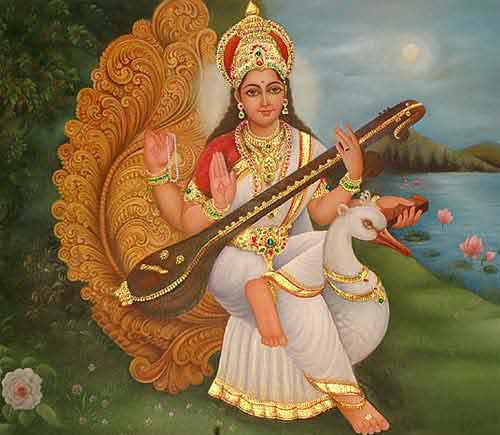
(Public Domain)
The Hamsa is also revered as a representation of Lord Vishnu and is often depicted as a mount for many major deities, including Goddess Saraswati – The goddess of knowledge, Gayatri – The goddess of the Vedas, and The supreme Goddess – shakti. Its association with these deities has further elevated its symbolic value. The graceful swan is also believed to embody purity and grace, making it an object of admiration and inspiration for many in the Hindu faith.
Naga
The cobra or the naga is a reptile that has made multiple appearances in sacred texts and scriptures throughout Hinduism. The snake symbolizes life, death, and rebirth as it sheds its figurative skin and lets go of its previous life.
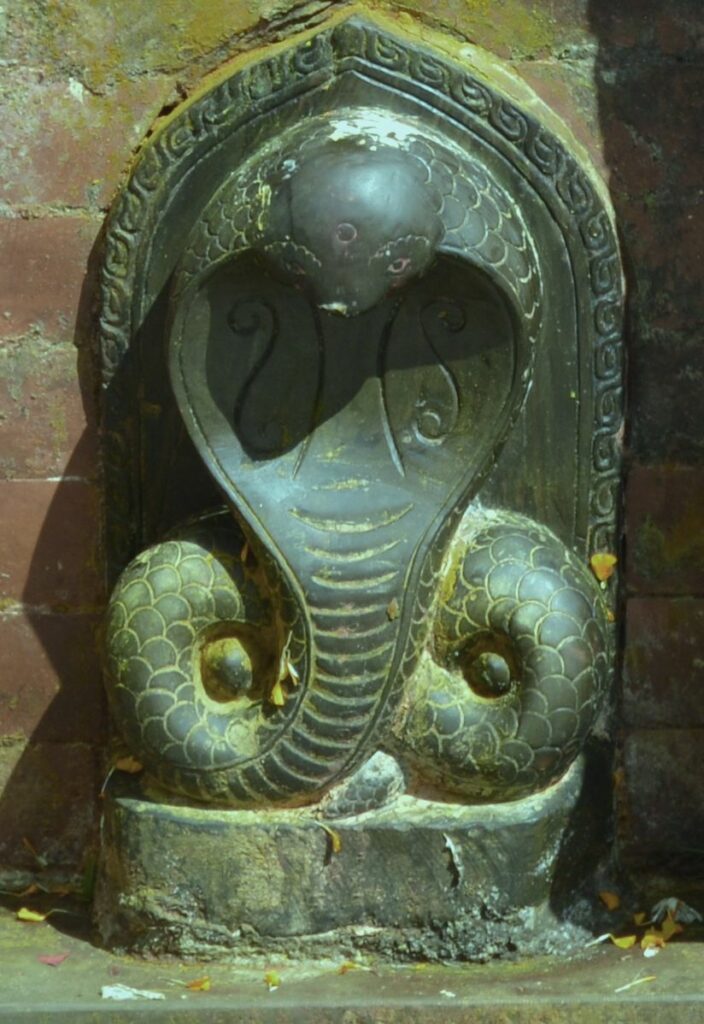
(Public Domain)
The Naga is most commonly associated with Lord Vishnu and plays a crucial role in many mythological tales. In spiritual depictions, the Naga serves as an umbrella over the deity, protecting it from the evils of the world.
Furthermore, the cobra also represents the kundalini energy within each individual. The kundalini is a cosmic power that lies dormant within us, and when awakened, helps individuals overcome suffering and challenges, leading to spiritual enlightenment.
Jewellery and Body Decorations
In Hinduism, many symbols are expressed through jewelry and other adornments on the body. Devotees take great pride in wearing these Hindu symbols as a way to demonstrate their dedication to the almighty. These symbols not only add aesthetic value but also hold great spiritual significance. Wearing these symbols is a way for devotees to connect with the divine and express their faith outwardly.
Tilaka
In Hinduism, Tilaka is a sacred mark that is worn on the forehead and other parts of the body to signify devotion to certain deities. It is applied using either a paste or powder made from spices such as sandalwood, saffron, turmeric, or vermilion.

(Public Domain)
Different shapes of tilaka represent different deities in Hinduism. For instance, a U-shaped tilaka signifies Lord Vishnu, while a tilak made up of three horizontal lines represents Lord Shiva.
Bindi
The Bindi is a sacred symbol in Hinduism, and its shape and color may vary depending on the region and culture. Traditionally, the bindi was a red dot, but today, it may also be shaped like a crescent, a triangle, or other designs. The color and shape of the bindi can also signify different aspects of Hinduism.

(Public Domain)
The Bindi is more than just a decorative item. It represents the third eye, the seat of wisdom and intuition, which is believed to be located between the eyebrows. The bindi is believed to help control the energy of the third eye and enhance concentration and focus.
In addition to its religious significance, the bindi has also become a fashion statement and is often worn by women as a decorative accessory. It can be worn by women of all ages, and there are many modern and creative designs available that blend traditional and contemporary styles. The bindi is an important symbol of Hindu culture and continues to be a part of Hindu women’s daily attire.
Vibhuti
Fire rituals, known as yagnas, have been an integral part of Hinduism for centuries. During these ceremonies, priests and devotees offer oblations of ghee, herbs, and other materials to the sacrificial fire while reciting mantras and prayers to various deities. The ash that remains after the fire has burned out is known as Vibhuti or Bhasma, and is considered a symbol of purity and divinity.

(Public Domain)
Vibhuti is often worn as a symbol of devotion and righteousness, particularly by followers of the Shaivite and Vaishnavite sects of Hinduism. The ash can be applied to the forehead, arms, and other parts of the body in various patterns and shapes, often representing specific deities such as Shiva or Vishnu.
Beyond its religious significance, Vibhuti is also a reminder of the impermanence of life and the transient nature of material existence. By wearing the ash, devotees are reminded of the ultimate fate of all living beings – to return to the earth in the form of ash or dust. This serves as a humbling reminder of the ephemeral nature of life and the need to cultivate detachment and spiritual awareness in the pursuit of higher truths.
Rudraksha
The Rudraksha seed is a small brown spherical object that serves as a prayer bead in Hinduism. Obtained from the Elaeocarpus Ganitrus tree, which is predominantly found in the Himalayan region, the Rudraksha seed is highly regarded for its spiritual significance.

(Public Domain)
In Hindu mythology, the Rudraksha seed is believed to be the teardrop of Lord Shiva, shed for the suffering of humanity. As a result, the Rudraksha seed has become a major symbol of Shiva and is highly valued by devotees. Multiple Rudraksha seeds are often strung together on a thread to create a garland, which provides protection to the wearer and is said to represent the eyes of Shiva. The Rudraksha is also believed to have healing properties and is said to bring the wearer peace and tranquility.
Tripundra
The Tripundra is a type of Tilaka, wherein a devotee applies three stripes of Vibhuti horizontally across their forehead along with a small red dot in the middle. The symbol is primarily worn by staunch devotees of Shiva, especially during the festive season.

(Public Domain)
The holy ash signifies purity and the removal of earthly pleasures in the form of anava, kama, and Maya. It is a widely held view that a person who wears a Tripundra leads a simple life adhering to Lord Shiva’s wishes.
The red circular symbol in the middle of the three stripes represents Shiva’s third eye. It is believed that the third eye helps a devotee see through the illusion of the world (Maya) and get spiritual insight.
Tiruvadi (Sacred Sandals)
In Hinduism, ascetics and yogis often lead a minimalist life, forsaking most worldly pleasures. The Tiruvadi or sacred sandals are one such object that helps them achieve this lifestyle. These sandals, also known as Paduka, are made of wood and are worn by ascetics during pilgrimages.

(Public Domain)
Tiruvadi sandals symbolize the holy feet of God, and it is believed that by touching the feet of a saint wearing Tiruvadi, a person is momentarily connected to God and attains the blessings of the Universe. These sandals serve as a reminder of the power of detachment and renunciation, which are essential aspects of the spiritual path in Hinduism. They also represent the idea that the true path to enlightenment lies not in material possessions, but in one’s devotion to the divine.
Symbolism in Spiritual Practices
Hinduism is a religion that heavily relies on symbolism, where the actions of a person hold deeper meanings rather than just the physical objects or icons. These actions, although abstract and complex at times, have been an essential part of Hinduism for millennia. Through these symbolic actions, individuals can connect with their inner selves and the divine, leading to a deeper understanding of the self and the universe.
Gopuram
The Gopuram is a tower built at the entrance of a temple. The architectural design of the Gopuram comprises an enormous stone base and a rectangular body topped with a barrel vault roof, sometimes resembling a pyramid. The size of the Gopurams is known to surpass 50 meters. The main structure has various inscriptions carved on the body often representing minor deities.
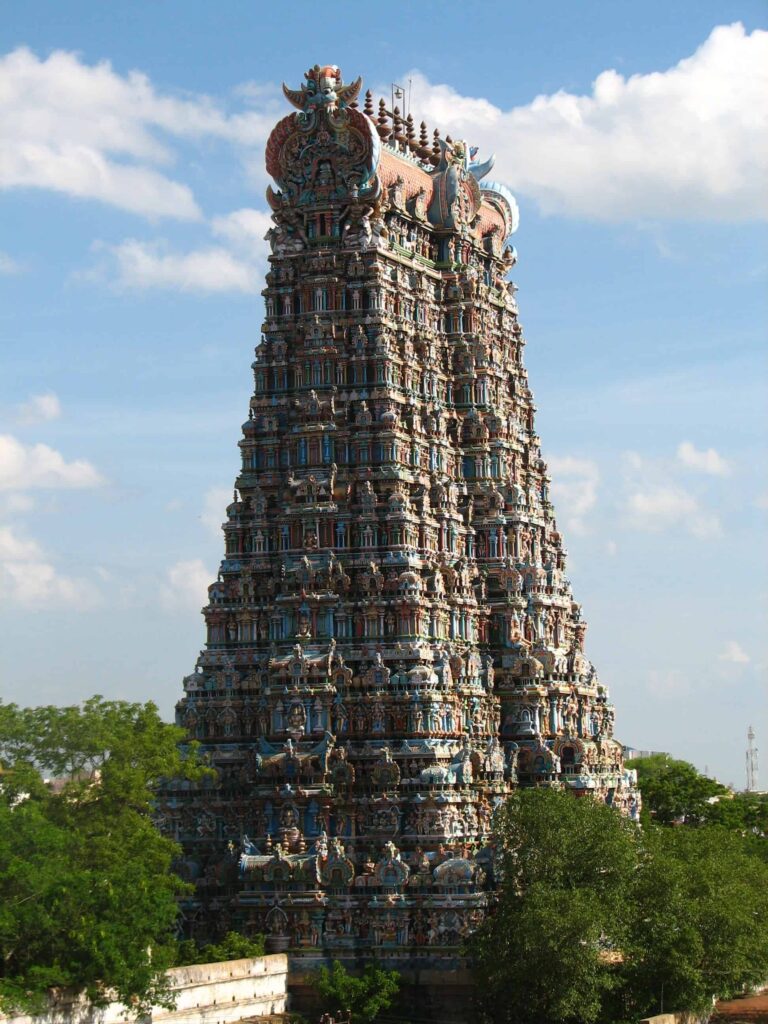
(Public Domain)
According to Hindu spiritual traditions, the Gopuram is symbolic of the feet of the divine. As a devotee enters through the Gopuram, he or she bows to pay respect to the deity. Gopurams are also symbolic of protection as it is believed that one cannot be harmed inside God’s abode. Passing through the Gopuram itself is a spiritual journey as the devotee leaves behind the materialistic world and arrives in the presence of the divine.
Ritual Fire
The ritual fire is one of the key elements of prayers in Hinduism and has remained so since the Vedic Ages. Within the fire ceremony, pandits and priests gather around a fire altar (Homakunda) and chant Vedic mantras while making offerings to the divine. It is through this fire that the Hindu devotees get to thank their lord for all his sacrifice and service. The ceremony also involves the people asking for good health and prosperity in return for their devotion The ritual fire essentially symbolizes a link between the devotees and the divine.

(Public Domain)
The fire is also symbolic of purity. Any object or person that successfully undergoes an agnipariksha or trial by fire, is considered to be pure and chaste. Fire in Hinduism also serves the very important purpose of providing a rite of passage to departed souls.
Ghanta or Bell
The Ghanta is a spiritual bell that is used for prayers and other religious ceremonies in Hinduism. A bell is consistently rung by a priest during prayer and is believed to inform the deity about the arrival of their devotees. Additionally, bells of different sizes are hung outside the Garbhagriha (God’s sanctum) in a temple. The sound dispelled by these bells is believed to scare away evil forces and strengthen the presence of God.
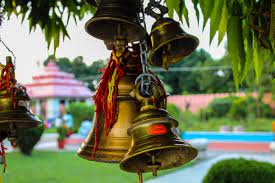
(Public Domain)
For most devotees of Hinduism, ringing a bell in front of a temple is itself a sign of devotion to their deity. The reverberations made by the ghanta waken the senses and help the devotee connect with their god.
Anjali Mudra
The Anjali Mudra, also known as Namaste, is a hand symbol in Hinduism wherein a person folds both their hands together completely touching the face of their palms. The gesture is used while practicing Yoga, greeting others, and most importantly during prayer.

(Public Domain)
The Anjali Mudra is the most universal non-verbal greeting and is considered a symbol of respect and reverence throughout the religion. The conjoined hands near the heart also symbolize the union of matter and spirit, the self and the Universe. When people see this hand gesture, they usually recognize it as “Namaste,” a Sanskrit word that roughly translates to “I bow to you” and is commonly used as a greeting in Hindu culture.
Deepak (Standing Oil Lamp)
The standing oil lamp or Kuttuvilaku is generally a tall brass lamp with a circular base at the top, where devotees pour oil and burn a small white wick. The burning of the lamp signifies the elimination of ignorance and the awakening of divinity within people.
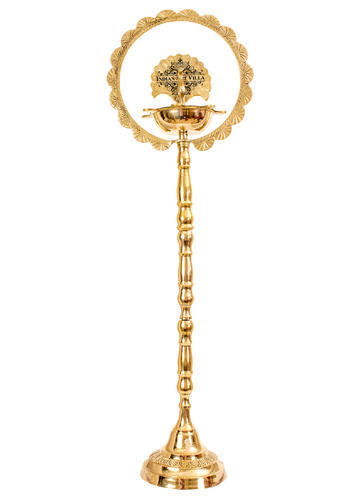
(Public Domain)
It also represents the banishment of evil as the fire dispels all negativity and brings about purity and serenity with its warm glow.
Conclusion
Religion is often communicated through symbolism, and this is particularly true in Hinduism. The religion’s rich and diverse symbols help to elucidate the complex and deeply spiritual beliefs that underpin it.
To an outsider, the symbols of Hinduism can be somewhat mystifying. With hundreds of symbols representing complex metaphysical concepts, it can be challenging to understand their significance. However, simply being able to recognize a symbol and appreciate its importance in Hinduism is an achievement in itself.


